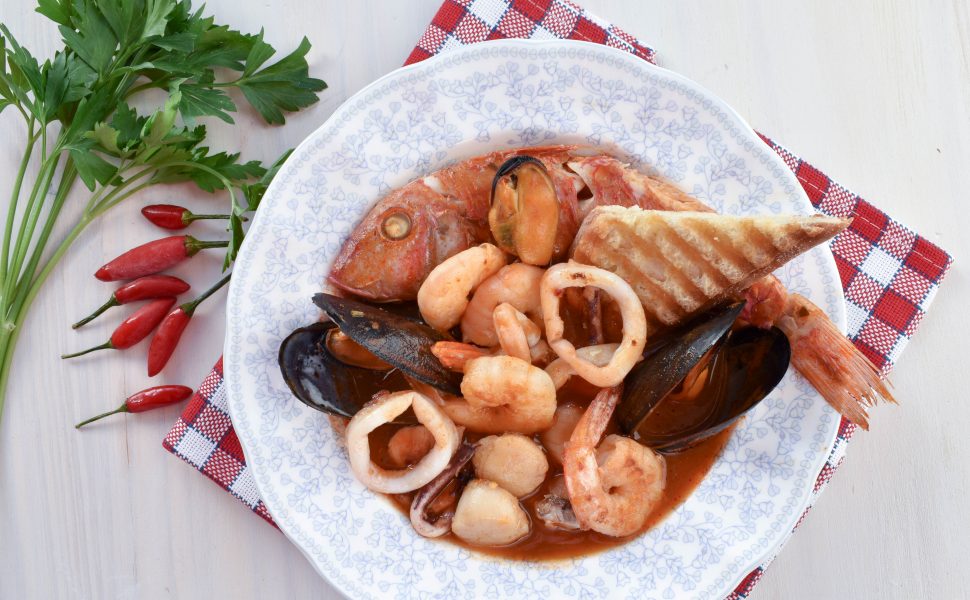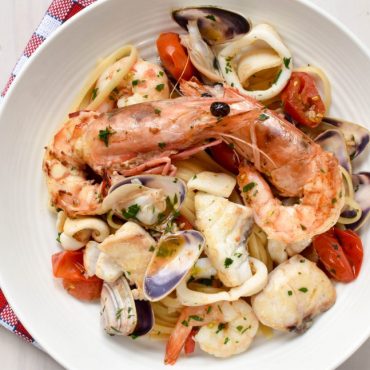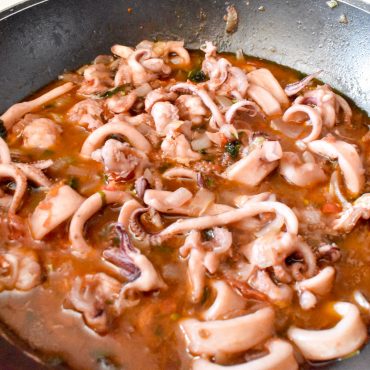Cacciucco alla Livornese (Livorno-style fish stew)
- 4 tablespoons (80ml) extra virgin olive oil
- 1 large onion, roughly chopped
- 1 garlic clove, finely chopped
- 2 small red chillies, finely sliced
- 2 carrots, peeled, roughly chopped
- 2 stalks celery, roughly chopped
- 70g tomato paste
- 200ml white wine
- 2 medium-sized calamari
- 600g mussels
- 400g blue-eye trevalla fillets (sablefish), or other firm, boneless fish fillets
- 4 red mullets, scaled and cleaned
- 600g raw prawns (medium shrimp), peeled
- 300g sea scallops
- 3 tablespoons flat-leaf parsley, finely chopped
- Grilled, crusty bread to serve
- Sea salt
- 1 kg fish bones and fish heads for stock (ask your local fishmonger), roughly chopped
- 2 tablespoons extra virgin olive oil
- 1 small onion, roughly chopped
- ½ leek, well washed, cut in half lengthways and roughly chopped
- 1 carrot, peeled, roughly chopped
- 1 stalk celery, roughly chopped
- 1 bay leaf
- Handful of flat-leaf parsley stalks
- 4 black peppercorns
- 200ml white wine
- 4L cold water
- Sea salt
To make the Brodo di Pesce (fish stock), rinse the fish bones under cold running water. Heat the olive oil in a large pot over medium heat. Add the onion and leek. Cook for 2 minutes, then stir in the carrot and celery. Cook for a further 3-4 minutes or until the onion and leek are soft. Add the fish bones and heads, bay leaf, parsley and peppercorns and cook for 2-3 minutes, then pour over the white wine. Cook for 2 minutes then add the water and salt to taste. Reduce the heat to low and simmer for 45 minutes – 1.5 hours.
Note: The longer that the fish stock cooks for, the more flavour it will develop.
Meanwhile to prepare the seafood:
-Remove the insides of the calamari by grasping the tube body and pulling the tentacles from the body. Cut off the tentacles of the calamari in one piece and set aside. Discard the insides and head of the calamari. Push the tentacles outwards, removing the beak at the base of the tentacles and discard. Remove the backbone (a thin, clear sliver of cartilage) from the tube of the calamari by holding onto the backbone and pulling it from the calamari tube. Lastly remove the calamari skin by running your fingers underneath the skin, then peeling it off. Remove the skin from the wings, body tube and tentacles and discard skin. Rinse the cavity well and pat dry, then cut the calamari into 1cm thick rings and consistent sized pieces
-Use a firm brush to scrub the mussels under cold running water to remove sand and barnacles. Discard any shells that are chipped, broken, or damaged in any way. Just before cooking, de-beard the mussels by holding a mussel between your thumb and forefinger. Using a paper towel to hold the beard and pull it downwards until it comes out and discard
-Slice the blue-eye trevalla fillets (or other firm, boneless fish fillets) into small pieces
Hold the red mullet firmly by the tail, lifting it slightly and scrape the scales in the direction from the tail toward the head using a butter knife or scaling tool. Using a pair of scissors, cut the vent along the soft belly and remove the innards. Wash the fish to remove slime and loose scales.
-Rinse prawns under cold running water. Remove the prawn head and tail, then peel off the shell and legs. To de-vein the prawn, use a sharp knife to cut a small line that runs down the length of the prawn’s back. Use the tip of the knife to pull out the intestinal tract and discard
Rinse sea scallops under cold running water and pat dry with paper towel.
Tip: To save time, ask your local fishmonger to clean the seafood for you
Remove the brodo di pesce (fish stock) from the heat and strain through a fine sieve into a bowl, using the back of the ladle to extract as much flavour as possible.
Note: If not used within 1 hour, refrigerate the stock.
To make the ‘soffritto’ (sautéed base flavouring) for the Cacciucco alla Livornese (Livorno-style fish stew), heat half of the olive oil in a large, heavy based stockpot over medium heat. Add half of the garlic, all of the chopped onion and half of the chilli. Cook for 2 minutes, then stir in the carrot and celery for 3-4 minutes or until the onion is soft. Add the tomato paste and cook, continuously stirring for 1 minute. Pour the white wine over the soffritto and cook until evaporated. Add the strained Brodo di Pesce (fish stock). Reduce the heat to low and simmer for 30 minutes.
Add the cleaned mussels and red mullet (whole) to the stockpot with fish stock. Meanwhile, heat the remaining olive oil in a large frying pan over medium-high heat. Add the remaining garlic and chilli and cook for 1 minute. Stir in the calamari and cook for 1 minute. Add the blue-eye trevalla fillets (or other firm, boneless fish fillets) and prawns (medium shrimp) and cook for 1 minute. Add the sea scallops and cook, stirring occasionally for 2 minutes. Remove from the heat.
Use a slotted spoon to remove the red mullet and mussels from the stockpot with fish stock and transfer to a plate. Strain the stock through a fine sieve into a bowl, using the back of the ladle to extract as much flavour as possible. Return the strained stock back to the stockpot. Transfer all seafood from the frying pan to the stockpot. Transfer the red mullet and mussels to the stockpot. Season with salt to taste. Cook for a further 3 minutes, then remove stockpot from the heat. Stir in the parsley.
To serve, divide the seafood among 4 serving bowls. Ladle the hot stock over the seafood. Serve the Cacciucco alla Livornese (Livorno-style fish stew) immediately with plenty of crusty bread – buon appetito.



